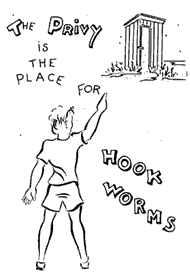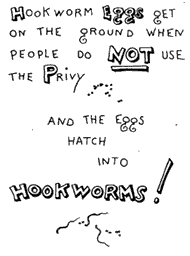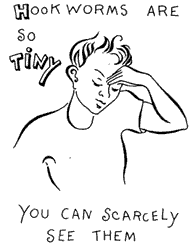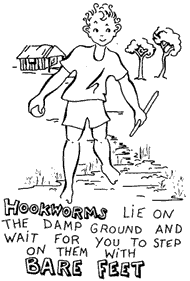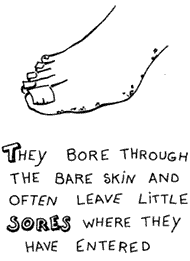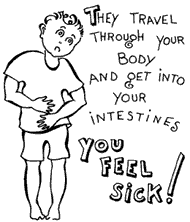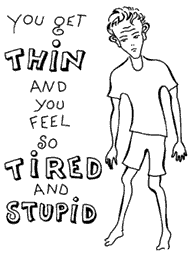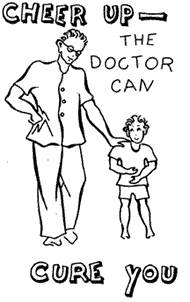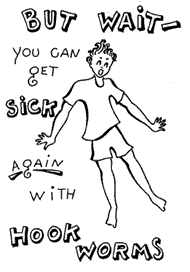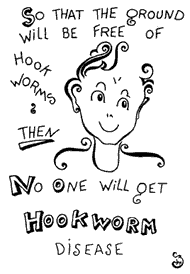In the late 1800s and early 1900s many homes in Mississippi and other rural American states did not have indoor plumbing and had inadequate sanitary facilities. Families could rarely afford to install indoor plumbing. Many Mississippians simply did not know how proper sanitary waste disposal and clean-living conditions could prevent diseases. As a result, they were often plagued with diseases that were directly linked to improper sanitary facilities. Hookworm was one such disease.
Threadlike worms
Hookworms live only in sandy or loamy soil like that found in many regions of Mississippi and other southern states. See map. They cannot exist in clay or muck. For hookworms to survive, rainfall averages must be more than forty inches a year, and the average temperature must exceed 50 degrees Fahrenheit. If these conditions exist, then the hookworm eggs hatch. After hatching, the larvae undergo two molts and transform into threadlike worms about one half of an inch long. They can then infect unsuspecting humans by boring into their bare feet or occasionally in their hands as the victim walked on or worked in the larval infested soil.
The hookworm species infecting people and found in Mississippi is Necator americanus or American Killer, a species that is distributed worldwide. See map. Doctors believe this species was unwittingly imported into the United States in the 17th century with the Atlantic slave trade.
The hookworm life cycle begins and ends in the human intestinal tract. Females may lay from 5,000 to 20,000 eggs a day after mating with the male in the host’s intestines. The eggs are then discharged in bowel movements. Sanitation practices at the turn of the 20th century were not ideal, and most rural Americans used the open outdoors as a toilet. Therefore, hookworm eggs constantly entered the soil in very large numbers.
The larva can move from side to side and is most active when dew is on the ground and temperatures are warm. While moving, if the larva haphazardly made contact with a person’s bare foot or hand, it quickly bored its way corkscrew-like into the skin and began its journey to the intestinal tract. At the site of entry, often a rash erupted which caused itching. This symptom was called “ground itch” or “dew itch.”
Since many Southerners did not wear shoes in summer months, hookworm larva usually penetrated between people’s toes. After making its way through the victim’s respiratory tract, the larva eventually found its way to the small intestine about one week later. Necator americanus has a pair of curved cutting plates in its mouth that allow it to attach to its host’s intestinal walls. It will live there, sucking the victim’s blood, about four to five years.
Pot belly and angel’s wings
People infected with hookworms often experienced a lack of energy but were not aware of the type parasite they had. In addition, coughing, wheezing, and fever sometimes developed in the victim as the larval migration traveled through the lungs. Infected people could also have stomach pains, pale yellowish-colored skin, feet that “go to sleep,” head and joint aches, weakness, vomiting, constipation, and diarrhea. Two classic visible signs of hookworm disease are a “pot belly”– an extended stomach – and “angel’s wings” – shoulder blades extended outward because of the host’s slumping, emaciated body. Blurred vision and a “fish-eye” stare characterized severe cases.
The primary danger of hookworm disease was anemia because the worms lived on the host’s plasma and excreted the red blood cells. The severity of the disease depended on the number of worms in the person’s gut. Death could result from secondary infections because of the host’s weakened condition. Hookworms were totally dependent on humans as hosts and on humans’ unhygienic practices to continue their life cycle.
Before 1900, few American physicians knew of hookworm disease. However, a zoologist from Hartford, Connecticut, Dr. Charles Wardell Stiles, studied medical zoology in Europe in the late 19th century and learned about hookworms while helping with animal autopsies and studies. Certain hookworm species live in specific animals.
When Stiles returned to the United States, he worked for the Bureau of Animal Industry of the Department of Agriculture in Washington, D.C., and taught at Johns Hopkins School of Medicine. He continually lectured his students about hookworms and the species that infect humans. Stiles helped spread information about the parasite and health problems associated with the worm, particularly in the South.
Rockefeller Sanitation Commission
In 1910, with a $1,000,000 philanthropic donation from the Rockefeller Sanitation Commission for the Eradication of Hookworm Disease, Dr. Waller S. Leathers, director of public health in Mississippi, began a three-staged plan to cope with hookworm disease. Hookworm disease had been identified in Mississippi only a few years prior to the Rockefeller donation. Leathers decided that the best way to combat the disease would be through the combination of health education, patient treatment, and community cooperation.
Public education on the disease was most important since large numbers of Mississippians were infested because of Mississippi’s soil and climatic conditions. As a result, areas in the state known as the Long Leaf Pine and Short Leaf Pine districts, the Coastal region, and the Central Prairie were the sections where Leathers and other doctors began their campaign against hookworm because they were the areas most heavily infested.
Leathers started his program by having hookworm exhibits at the 1910 Jackson State Fair and the Harrison County Fair. He knew that thousands of Mississippians who attended the fairs would see the hookworm information and learn how to control the spread of the worms through proper sanitation.
The Mississippi State Board of Health under Leathers’s direction also began distributing literature about hookworm disease to school children throughout the state. Students between the ages of six and eighteen were tested in the most heavily infested regions. Doctors discovered heavy hookworm infestations among the school children. They sent instructions home to parents on how to take proper health measures such as the need to wear shoes and how to build sanitary privies, or outhouses.
Build better outhouses
The State Board of Health provided instructions on how to build better enclosed outhouses so that waste products would not flow out into the surrounding soil and animals could not break in and distribute the waste. The State Board of Health even helped schools build new privies for the children. Before privies were provided, many schoolchildren in the state simply had as a school bathroom facility one side of the nearby woods for girls and one side for boys.
Better health standards were stressed for all who lived in the infected areas. Mississippians of all ages reacted positively to Leathers’s efforts and they sought treatment or either improved their sanitary facility or constructed new ones.
Dispensary opens in Columbia
The first dispensary for treating hookworm disease opened December 18, 1910, in Columbia, Mississippi. People could go there for testing and treatment. Treatment involved a single dose of thymol to kill the worms, followed later by an enema, usually of epsom salts, to rid the body of the dead worms. Later, tetracholorethylene became the preferred treatment to kill hookworms. Dr. Charles C. Bass and Dr. Hector H. Howard organized the Columbia clinic. Their dispensary was so successful that it became the model for others throughout the state and the South. By 1912, eleven southern states had dispensaries based on the one in Columbia.
The Rockefeller Sanitation Commission continued to provide funds for free clinic treatments to Mississippians until 1915. Over the five-year period, 166,623 people in 78 counties were examined in the state. The infection rate among adults was 34.1 percent and 36.7 percent among school children. Mississippians had also learned during this time to practice proper sanitary methods to prevent the spread of hookworm eggs. With these combined efforts, progress was made toward eliminating hookworm disease in Mississippi.
However, hookworms continued to be a health problem in Mississippi as late as 1981 when sixty-nine cases were reported to the State Board of Health. As late as the early 1980s, some Mississippians still did not have adequate sanitary facilities; therefore, hookworms still maintained a niche in the sandy, loamy soil environment in the original heavily infested regions in the state.
At the turn of the 21st century, hookworm disease is virtually unheard of in Mississippi because of education, proper sanitation disposal, and good medical practices.
Deanne Stephens Nuwer, Ph.D., is an assistant professor of history at the University of Southern Mississippi.
Suggested Further Readings
Clark, Thomas D. The Emerging South. New York: Oxford University Press, 1981.
Savitt, Todd and James Harvey Young, eds. Disease and Distinctiveness in the American South. Knoxville: University of Tennessee Press, 1988.
Savitt, Todd. Medicine and Slavery: The Diseases and Health Care of Blacks in Antebellum Virginia. Urbana: University of Illinois Press, 1978.
Williams, Greer. The Plague Killers, New York: Charles Scribe’s Sons, 1989.

